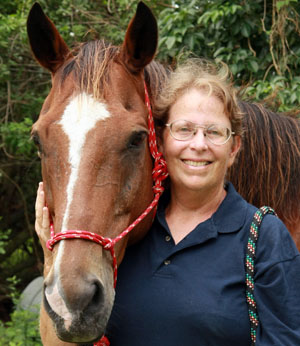TAILS FROM THE TRAILS
Talk about someone who’s found a way to make horses more than a hobby! Jennifer Benoit is living an enviable life, although it didn’t seem that way a while back.
She was working as a medical device sales rep and also competing at the Grand Prix level when she became pregnant plus had to contend with two herniated discs in her back. After she gave birth, she had back surgery — and then got laid off.
Her husband, Chris, viewed the change as an opportunity, however — a way for Benoit to morph her hobby into a business.
“He’d watched me buy, sell and trade horses over the years,” she said. “He saw my job loss as a sign that I should do it professionally. So, last year, we moved from Boca to Wellington, bought this property and began Seahorse Stables.”
The property, on Indian Mound Road, includes 5 acres and an eight-stall barn. Some clients board with Benoit, especially during the season, and others trailer in for lessons.
Why Seahorse?
“It’s a lucky emblem for us. Chris loves boats and the ocean, and I love horses. It became our symbol. When we bought this place, he sold a yacht and I sold a very nice Grand Prix horse,” Benoit said, smiling as she explains the next part. “Also, seahorses are the only species where the male gives birth. That suits me fine.”
As for being a USEF judge, Jennifer received her “r” rating in 2005.
“I wanted to become a better rider and competitor,” she explained. “I wanted to see what dressage looked like from the judges’ perspective. The hardest part is sitting still and watching others ride. The best part is being able to give helpful and encouraging comments.”
Benoit explains that becoming a judge is a very rigorous program in which you meet certain requirements at each level, and you have to remain at each level at least two years before moving up.
“I started early, because it can easily take 15 years or more to reach FEI level,” she said. “I’ve been accepted into the ‘R’ level, and I’m waiting to be tested. The tests include practical exams, where you sit with judges and see how they’re scoring riders. You also judge the same classes and then compare your score sheets with those of the judges. It’s very much an apprenticeship.”
Among other requirements, you need the recommendations of 25 judges at that level. “This isn’t an easy goal to achieve, but I’m glad it’s difficult,” Benoit said. “It should be something that not just anyone could do. You have to work hard at it and really want it.”
What does she look for when she’s judging?
“I want to see purity of gaits, expression, impulsion, submission and a harmonious picture of horse and rider. I want to see a happy horse, one who’s working hard and enjoying his job,” Benoit said. “If there’s a problem with the horse, many times it’s caused by the rider sitting or using herself incorrectly. Judges don’t give training tips, just observations. Since the horse is 95 percent of the score, a so-so rider can compete on a really nice horse and do quite well.”
Benoit really cares about the horses she rides and judges. One time, as a judge, she stopped a rider in a schooling show and asked her to leave the ring because she wouldn’t stop yanking on her pony’s mouth.
A common fault she often sees?
“Novice dressage riders have a misconception that horses have to be rounder and deeper, so they pull the head down to make the neck rounder and push for bigger movements, instead of teaching a horse to find a comfortable headset on the bit and use himself correctly,” Benoit said. “They should think about motivating the horse to move forward from his quarters, not just submit to unyielding hands. Young horses, in particular, should never be too collected at the walk. Riding should be enjoyable for both horse and rider.”
Benoit is also a certified equine appraiser with the American Society of Equine Appraisers, which she said is a great deal of fun.
“There’s always someone with a list of requirements looking for a dressage horse. I can try the horse for them, shoot a video, talk with a vet, set up a pre-purchase exam, video the flexion test, negotiate the price, write the bill of sale, arrange shipping — everything,” she explained. “A big part is establishing a horse’s fair market value by comparing it to similar recently sold horses. This is commonly done during a divorce, buying out half of a syndicated stallion, donating a horse to a charity or making an insurance claim.”
In teaching her students, Benoit evaluates what they’re doing and advises them how to strengthen weaknesses so they can improve and move up a level.
Ellen Reeder is one of her students. She splits her time between Monkton, Md., and Wellington. She met Benoit through a friend last year.
“She’s marvelous, a superb fit,” Reeder said. “She matches my personality and interacts wonderfully with my horse, a big German Warmblood. She makes him happy. Each day, when I ride with her, she has a plan all thought out as to what we’ll work on, what games he’ll play. She always keeps his tempo and mood in mind. She lets him be proud of what he’s done and makes riding fun for both me and my horse.”
Benoit is always teaching, Reeder said. “Even when we’re taking a break or walking out, she talks with me and teaches me things,” Reeder added. “She’s very observant and detail-oriented, catches even minor things early before they turn into big problems. She’s intelligent, poised, has a lot of empathy, is very capable, and just plain fun to be with.”
For more information, visit www.seahorsewellington.com, or call (561) 309-7300.








